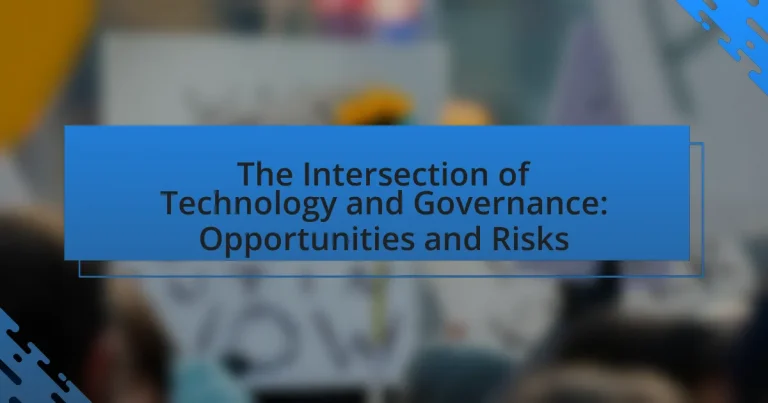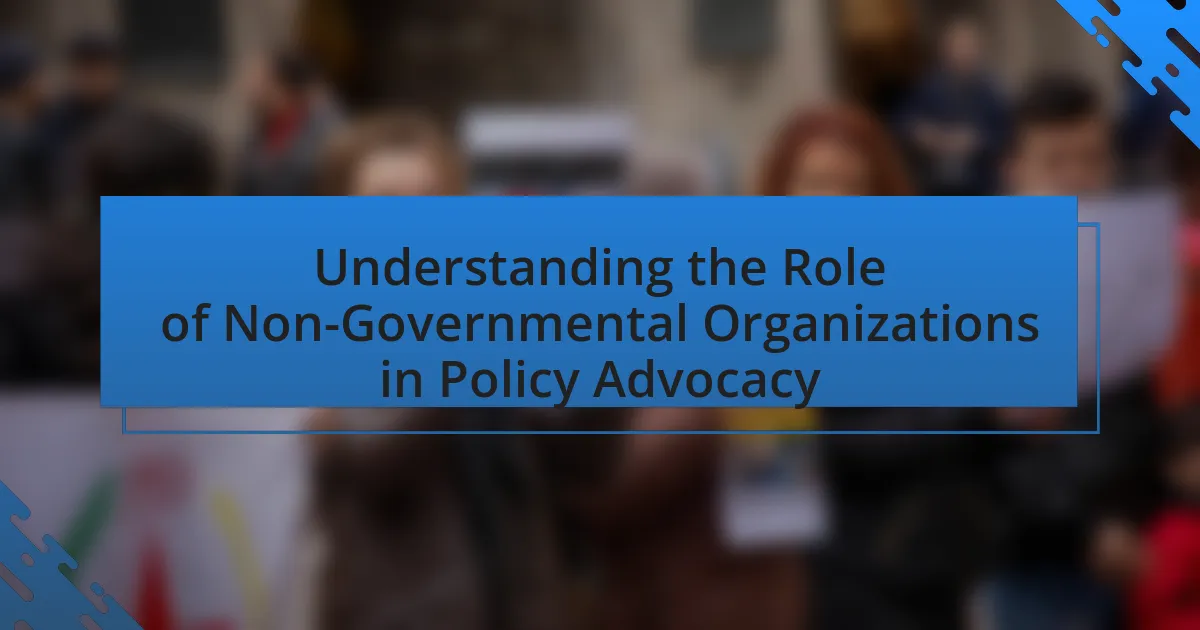The article examines the intersection of technology and governance, highlighting how digital tools enhance public administration and citizen engagement. It discusses the integration of technologies such as artificial intelligence, blockchain, and big data analytics in governance, which improve efficiency, transparency, and decision-making. The article also addresses the historical evolution of technology in governance, the economic benefits of digital integration, and the associated risks, including data privacy concerns and algorithmic bias. Furthermore, it outlines future trends and practical steps for effectively navigating the challenges and opportunities presented by this intersection.
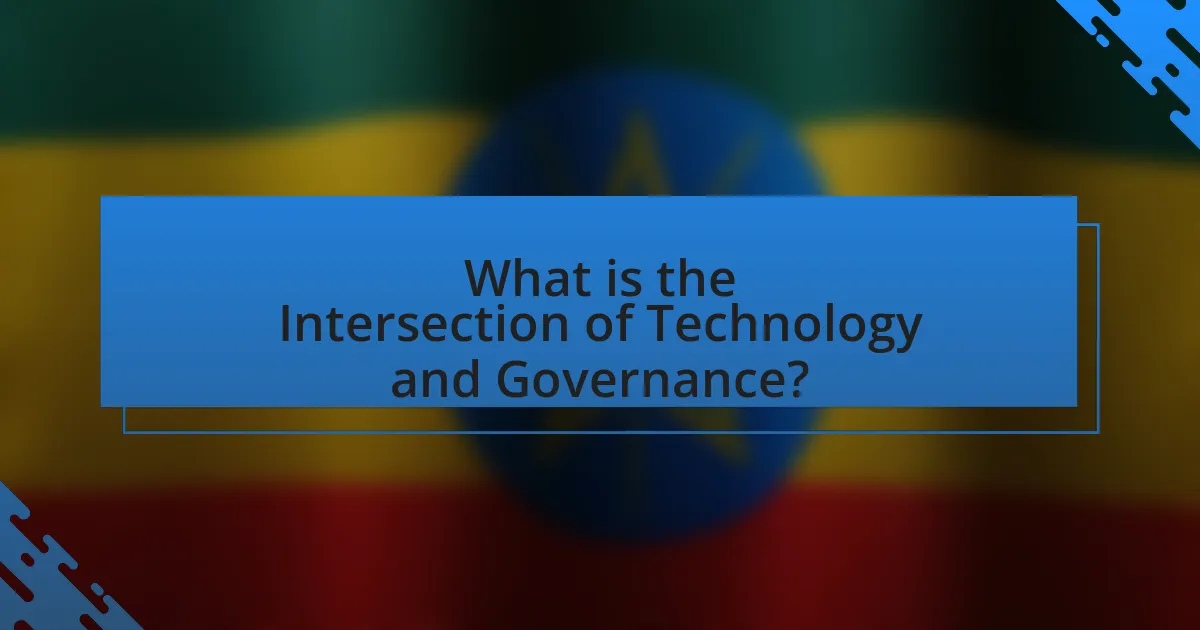
What is the Intersection of Technology and Governance?
The intersection of technology and governance refers to the integration of digital tools and systems into the processes of public administration and policy-making. This integration enhances efficiency, transparency, and citizen engagement in governance. For instance, the use of data analytics in decision-making allows governments to respond more effectively to public needs, as evidenced by the implementation of smart city initiatives that utilize real-time data to improve urban services. Additionally, technologies like blockchain can increase transparency in government transactions, reducing corruption. These advancements illustrate how technology can transform governance by making it more responsive and accountable to citizens.
How do technology and governance interact in modern society?
Technology and governance interact in modern society through the integration of digital tools and platforms that enhance public administration and citizen engagement. Governments utilize technology to improve service delivery, increase transparency, and facilitate communication with citizens, exemplified by the implementation of e-governance systems that streamline processes and provide access to information. For instance, according to a report by the United Nations, over 80% of countries have adopted some form of e-government services, which demonstrates the widespread recognition of technology’s role in enhancing governance. Additionally, technology enables data-driven decision-making, allowing governments to analyze trends and respond effectively to societal needs. This interaction also presents challenges, such as cybersecurity threats and the digital divide, which can exacerbate inequalities if not addressed.
What are the key technologies influencing governance today?
Key technologies influencing governance today include artificial intelligence, blockchain, big data analytics, and the Internet of Things (IoT). Artificial intelligence enhances decision-making processes by providing data-driven insights, as seen in predictive analytics used for public policy. Blockchain technology improves transparency and accountability in government transactions, evidenced by its application in secure voting systems. Big data analytics enables governments to analyze vast amounts of information for better resource allocation and service delivery, demonstrated by cities using data to optimize traffic management. The Internet of Things facilitates real-time monitoring of public infrastructure, improving maintenance and service efficiency, as shown in smart city initiatives.
How does governance shape the development of technology?
Governance shapes the development of technology by establishing regulatory frameworks that influence innovation, funding, and ethical standards. For instance, government policies can incentivize research and development through grants and tax breaks, as seen in the U.S. government’s support for renewable energy technologies, which has led to significant advancements in solar and wind energy. Additionally, governance can impose regulations that ensure technologies are developed responsibly, such as data protection laws that guide how companies handle personal information, thereby fostering public trust and encouraging wider adoption of new technologies.
What are the historical contexts of technology in governance?
The historical contexts of technology in governance include the evolution of communication methods, data management, and decision-making processes that have shaped political structures. For instance, the invention of the printing press in the 15th century revolutionized the dissemination of information, enabling governments to communicate policies and engage with citizens more effectively. In the 20th century, the introduction of computers and the internet transformed data management, allowing for more efficient record-keeping and analysis, which enhanced governmental transparency and accountability. Additionally, the use of surveillance technologies has raised ethical concerns regarding privacy and civil liberties, illustrating the dual-edged nature of technological advancements in governance. These historical developments demonstrate how technology has continuously influenced governance practices and public administration throughout history.
How has technology evolved in relation to governance over the decades?
Technology has evolved significantly in relation to governance over the decades, transitioning from basic record-keeping systems to advanced digital platforms that enhance transparency and citizen engagement. In the 1960s and 1970s, governments primarily utilized mainframe computers for data management, which improved efficiency but limited public access. The 1990s saw the advent of the internet, enabling governments to provide information online and interact with citizens through email and websites, exemplified by initiatives like the U.S. government’s FirstGov portal launched in 2000.
In the 2000s, the rise of social media and mobile technology further transformed governance by facilitating real-time communication and feedback between citizens and officials. For instance, platforms like Twitter became vital during events such as the Arab Spring, where they were used for organizing protests and disseminating information. More recently, the integration of big data and artificial intelligence has allowed for data-driven decision-making in governance, improving public services and policy formulation.
As of 2023, technologies such as blockchain are being explored for enhancing transparency in voting and public records, demonstrating an ongoing evolution towards more secure and accountable governance systems. This trajectory illustrates a clear shift towards leveraging technology to foster greater citizen participation and improve governmental efficiency.
What major events have highlighted the intersection of technology and governance?
Major events that have highlighted the intersection of technology and governance include the Cambridge Analytica scandal, the implementation of GDPR in the European Union, and the rise of blockchain technology in public administration. The Cambridge Analytica scandal in 2016 revealed how personal data from Facebook was used to influence political campaigns, raising concerns about data privacy and electoral integrity. The General Data Protection Regulation (GDPR), enacted in 2018, established strict guidelines for data protection and privacy, showcasing how governance can adapt to technological advancements. Additionally, the adoption of blockchain technology in various government sectors has demonstrated its potential for enhancing transparency and efficiency in public services, as seen in initiatives like Estonia’s e-residency program. These events collectively illustrate the ongoing challenges and opportunities at the intersection of technology and governance.
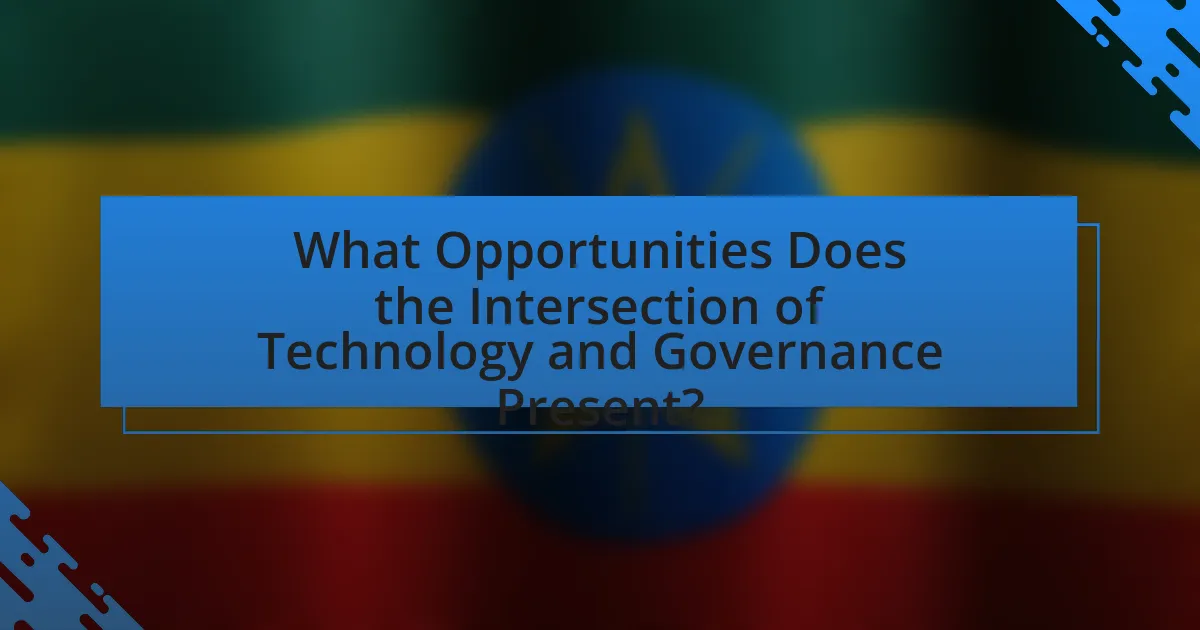
What Opportunities Does the Intersection of Technology and Governance Present?
The intersection of technology and governance presents opportunities for enhanced efficiency, transparency, and citizen engagement. Technology enables governments to streamline processes through automation and data analytics, leading to faster decision-making and resource allocation. For instance, the use of blockchain technology can improve transparency in public records and reduce corruption by providing immutable transaction logs. Additionally, digital platforms facilitate greater citizen participation in governance, allowing for real-time feedback and more responsive policy-making. According to a report by the World Economic Forum, governments that adopt digital tools can improve service delivery and foster trust among citizens, ultimately leading to more effective governance.
How can technology enhance governmental efficiency?
Technology can enhance governmental efficiency by streamlining processes, improving data management, and facilitating communication. For instance, the implementation of digital platforms allows for quicker processing of applications and permits, reducing wait times for citizens. A study by the McKinsey Global Institute found that digitizing government services can lead to a 20-30% increase in efficiency, as it minimizes paperwork and manual errors. Additionally, technologies such as data analytics enable governments to make informed decisions based on real-time data, improving resource allocation and service delivery.
What specific technologies are being used to streamline government processes?
Specific technologies used to streamline government processes include cloud computing, artificial intelligence (AI), blockchain, and robotic process automation (RPA). Cloud computing enables scalable data storage and access, facilitating efficient information sharing among agencies. AI enhances decision-making through data analysis and predictive modeling, improving service delivery. Blockchain provides secure and transparent transaction records, reducing fraud and increasing trust in government operations. RPA automates repetitive tasks, allowing government employees to focus on more complex issues. These technologies collectively improve efficiency, reduce costs, and enhance citizen engagement in government services.
How does technology improve citizen engagement in governance?
Technology improves citizen engagement in governance by facilitating direct communication between citizens and government entities. Digital platforms, such as social media, mobile applications, and online forums, enable citizens to voice their opinions, participate in discussions, and provide feedback on policies in real-time. For instance, a study by the Pew Research Center found that 69% of adults in the U.S. use social media, which serves as a vital tool for civic engagement, allowing for broader participation in governance processes. Additionally, e-governance initiatives streamline access to information and services, making it easier for citizens to engage with their local governments. This increased accessibility fosters transparency and accountability, ultimately enhancing the democratic process.
What economic benefits arise from integrating technology into governance?
Integrating technology into governance yields significant economic benefits, including increased efficiency, cost savings, and enhanced transparency. For instance, the implementation of e-governance platforms can streamline administrative processes, reducing the time and resources required for public service delivery. According to a study by the McKinsey Global Institute, digitizing government services can lead to a potential annual savings of $1 trillion globally by improving operational efficiency. Furthermore, technology fosters transparency, which can reduce corruption and increase public trust, ultimately attracting investment and stimulating economic growth.
How does technology drive innovation in public services?
Technology drives innovation in public services by enhancing efficiency, improving service delivery, and enabling data-driven decision-making. For instance, the implementation of cloud computing allows public agencies to streamline operations and reduce costs, as seen in the U.S. government’s adoption of cloud services, which reportedly saved over $5 billion annually. Additionally, technologies like artificial intelligence and machine learning facilitate personalized services and predictive analytics, improving citizen engagement and resource allocation. The integration of digital platforms, such as e-governance systems, further exemplifies how technology fosters transparency and accessibility, leading to more responsive public services.
What role does technology play in reducing government costs?
Technology plays a crucial role in reducing government costs by streamlining operations and enhancing efficiency. For instance, the implementation of digital services allows governments to automate processes, which reduces the need for manual labor and minimizes errors. A study by the McKinsey Global Institute found that digitizing government services could save up to $1 trillion annually in the U.S. alone by improving service delivery and reducing administrative overhead. Additionally, technologies such as cloud computing enable governments to lower IT infrastructure costs while increasing accessibility and collaboration among departments. These advancements demonstrate that technology not only cuts costs but also improves the overall effectiveness of government operations.
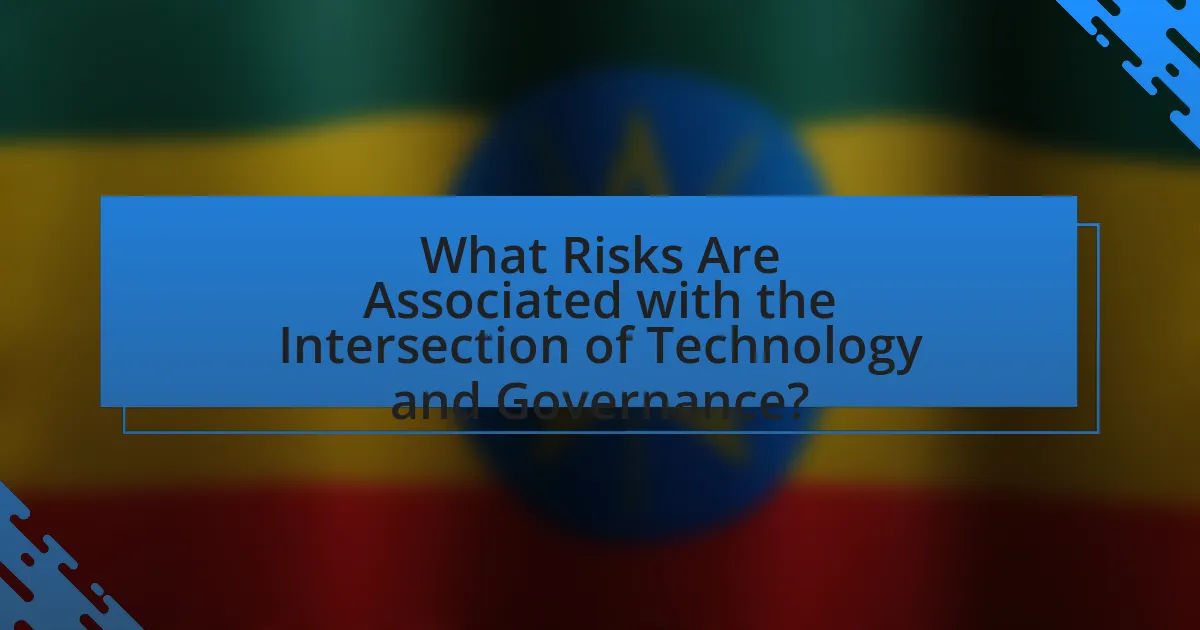
What Risks Are Associated with the Intersection of Technology and Governance?
The risks associated with the intersection of technology and governance include data privacy breaches, algorithmic bias, and the erosion of democratic processes. Data privacy breaches occur when sensitive information is inadequately protected, leading to unauthorized access and misuse, as evidenced by incidents like the Cambridge Analytica scandal, where personal data of millions was exploited without consent. Algorithmic bias can result in unfair treatment of individuals based on flawed data or programming, impacting areas such as law enforcement and hiring practices, which has been documented in studies showing racial bias in predictive policing algorithms. Additionally, the erosion of democratic processes can happen when technology facilitates misinformation and manipulation, undermining public trust and informed decision-making, as seen in various elections worldwide where social media played a pivotal role in spreading false information.
What are the potential threats to privacy and security?
Potential threats to privacy and security include data breaches, surveillance, and cyberattacks. Data breaches occur when unauthorized individuals access sensitive information, often resulting in identity theft and financial loss; for instance, the 2017 Equifax breach exposed personal data of 147 million people. Surveillance, both by governments and corporations, raises concerns about the erosion of civil liberties and the potential misuse of collected data. Cyberattacks, such as ransomware, can disrupt services and compromise sensitive information, with the 2021 Colonial Pipeline attack exemplifying the severe impact on critical infrastructure. These threats highlight the vulnerabilities inherent in the intersection of technology and governance.
How can technology lead to surveillance and data misuse?
Technology can lead to surveillance and data misuse through the collection, storage, and analysis of personal information without consent. For instance, advancements in data analytics and artificial intelligence enable organizations to track individuals’ online behaviors, often aggregating data from various sources, such as social media and online transactions. This capability can result in unauthorized surveillance, as seen in cases where governments or corporations monitor citizens’ activities under the guise of security or marketing. A notable example is the Cambridge Analytica scandal, where personal data from millions of Facebook users was harvested without consent for political advertising, highlighting the potential for misuse of technology in data handling.
What measures can be taken to protect citizen data?
To protect citizen data, implementing robust encryption methods is essential. Encryption secures data by converting it into a format that can only be read by authorized users, thereby preventing unauthorized access. For instance, the use of Advanced Encryption Standard (AES) has been widely adopted in various sectors, ensuring that sensitive information remains confidential during transmission and storage. Additionally, regular security audits and compliance with data protection regulations, such as the General Data Protection Regulation (GDPR), further enhance data security by establishing clear guidelines for data handling and user consent. These measures collectively contribute to a more secure environment for citizen data.
How does technology impact democratic processes?
Technology significantly impacts democratic processes by enhancing communication, increasing voter engagement, and facilitating access to information. For instance, social media platforms allow for real-time dissemination of political information, enabling citizens to engage in discussions and mobilize for causes. According to a study by the Pew Research Center, 69% of adults in the U.S. use social media, which has become a critical tool for political campaigns and grassroots movements. Additionally, technology enables online voting and e-governance, making it easier for citizens to participate in elections and access government services. However, it also poses risks such as misinformation and cyber threats, which can undermine the integrity of democratic processes.
What are the risks of misinformation and digital manipulation?
Misinformation and digital manipulation pose significant risks to society, including the erosion of trust in institutions, the polarization of public opinion, and the undermining of democratic processes. These risks manifest as individuals and groups may be misled by false information, leading to misguided beliefs and actions. For instance, a study by the Pew Research Center found that 64% of Americans believe that fabricated news stories cause confusion about the basic facts of current events. Additionally, digital manipulation techniques, such as deepfakes and bots, can amplify false narratives, further distorting public perception and hindering informed decision-making. This manipulation can also incite social unrest, as seen in various political events worldwide where misinformation has fueled protests and violence.
How can technology influence voter behavior and election outcomes?
Technology can significantly influence voter behavior and election outcomes by shaping information access, communication methods, and engagement strategies. For instance, social media platforms like Facebook and Twitter allow political campaigns to target specific demographics with tailored messages, which can sway voter opinions and increase turnout. A study by the Pew Research Center found that 69% of adults in the U.S. use social media, highlighting its role in shaping political discourse and mobilizing voters. Additionally, online voting systems and mobile applications can enhance voter participation by making the voting process more accessible, as evidenced by the increased turnout in jurisdictions that implemented such technologies. These factors demonstrate that technology not only alters how voters receive information but also impacts their likelihood to engage in the electoral process.
What ethical considerations arise from the use of technology in governance?
The ethical considerations arising from the use of technology in governance include privacy concerns, data security, algorithmic bias, and transparency. Privacy concerns emerge as governments collect vast amounts of personal data, potentially infringing on individual rights. Data security is critical, as breaches can expose sensitive information, undermining public trust. Algorithmic bias can lead to discriminatory practices in decision-making processes, affecting marginalized communities disproportionately. Transparency is essential to ensure accountability, as opaque technological systems can obscure governmental actions and decisions. These considerations highlight the need for ethical frameworks to guide the integration of technology in governance, ensuring that it serves the public good while protecting individual rights.
How do biases in technology affect governance decisions?
Biases in technology significantly affect governance decisions by influencing the data-driven algorithms that inform policy-making. For instance, biased algorithms can lead to unequal resource allocation, as seen in predictive policing tools that disproportionately target minority communities, thereby perpetuating systemic inequalities. Research by ProPublica in 2016 highlighted that a widely used risk assessment tool in criminal justice was biased against African American defendants, leading to unfair sentencing outcomes. Such biases can distort the decision-making process, resulting in governance that fails to represent the needs of all citizens equitably.
What frameworks exist to ensure ethical technology use in governance?
Several frameworks exist to ensure ethical technology use in governance, including the OECD Principles on Artificial Intelligence, the EU’s General Data Protection Regulation (GDPR), and the IEEE Global Initiative on Ethics of Autonomous and Intelligent Systems. The OECD Principles provide guidelines for responsible stewardship of AI, emphasizing transparency, accountability, and fairness. The GDPR establishes strict data protection standards, ensuring individuals’ rights over their personal data, which is crucial for ethical governance. The IEEE initiative focuses on ethical considerations in the development and deployment of intelligent systems, promoting human-centric design and societal well-being. These frameworks collectively aim to guide policymakers and organizations in implementing technology that aligns with ethical standards and societal values.
How can stakeholders mitigate the risks associated with technology in governance?
Stakeholders can mitigate the risks associated with technology in governance by implementing robust cybersecurity measures, establishing clear regulatory frameworks, and promoting transparency in technology use. Cybersecurity measures, such as encryption and regular security audits, protect sensitive data from breaches, which is critical given that, according to a 2021 report by Cybersecurity Ventures, cybercrime is projected to cost the world $10.5 trillion annually by 2025. Regulatory frameworks provide guidelines that ensure technology is used ethically and responsibly, reducing the likelihood of misuse. Transparency fosters public trust and accountability, as seen in initiatives like open data policies, which have been shown to enhance citizen engagement and oversight in governance.
What best practices should governments adopt for responsible technology use?
Governments should adopt transparency, accountability, and inclusivity as best practices for responsible technology use. Transparency involves clear communication about technology policies and their implications, ensuring citizens understand how their data is used. Accountability requires establishing frameworks that hold technology providers and government agencies responsible for ethical practices, as seen in the implementation of the General Data Protection Regulation (GDPR) in the European Union, which enforces strict data protection standards. Inclusivity ensures that technology benefits all citizens, particularly marginalized groups, by actively involving diverse stakeholders in decision-making processes, as demonstrated by initiatives like the Digital Equity Act in the United States, which aims to bridge the digital divide. These practices collectively foster trust and promote equitable access to technology.
How can collaboration between tech companies and governments enhance governance?
Collaboration between tech companies and governments can enhance governance by leveraging technology to improve public services and increase transparency. For instance, the implementation of digital platforms by tech firms can streamline government processes, making them more efficient and accessible to citizens. A notable example is Estonia, which has successfully integrated digital identity systems and e-governance solutions, resulting in significant improvements in service delivery and citizen engagement. This collaboration can also foster data sharing, enabling governments to make informed decisions based on real-time analytics, thereby enhancing policy effectiveness. Furthermore, partnerships can drive innovation in areas such as cybersecurity, ensuring that governance frameworks are resilient against emerging threats.
What are the future trends in the intersection of technology and governance?
Future trends in the intersection of technology and governance include increased adoption of artificial intelligence for decision-making, enhanced transparency through blockchain technology, and the rise of digital identity systems. Artificial intelligence is expected to streamline public services and improve policy analysis, as evidenced by initiatives in countries like Estonia, which utilizes AI for administrative tasks. Blockchain technology will likely enhance transparency and accountability in government transactions, as seen in pilot projects across various jurisdictions that aim to reduce corruption. Additionally, digital identity systems are anticipated to facilitate secure access to services, with countries like India implementing biometric identification to streamline welfare distribution. These trends indicate a shift towards more efficient, transparent, and citizen-centric governance models.
How might emerging technologies reshape governance in the next decade?
Emerging technologies will reshape governance in the next decade by enhancing transparency, improving citizen engagement, and streamlining public services. For instance, blockchain technology can provide secure and transparent record-keeping, which can reduce corruption and increase trust in governmental processes. Additionally, artificial intelligence can analyze large datasets to inform policy decisions, making governance more data-driven and responsive to citizen needs. A report by the World Economic Forum highlights that 80% of government leaders believe that digital transformation will significantly impact public sector efficiency. These advancements will likely lead to more participatory governance models, where citizens can engage directly with decision-making processes through digital platforms.
What role will artificial intelligence play in future governance models?
Artificial intelligence will play a transformative role in future governance models by enhancing decision-making processes, improving efficiency, and enabling data-driven policy formulation. AI systems can analyze vast amounts of data to identify trends and predict outcomes, which allows governments to make informed decisions that are responsive to citizen needs. For instance, AI can optimize resource allocation in public services, as demonstrated by cities using predictive analytics to manage traffic flow and reduce congestion. Furthermore, AI can facilitate citizen engagement through chatbots and automated systems that provide real-time information and feedback mechanisms, thereby increasing transparency and accountability in governance.
What practical steps can be taken to navigate the intersection of technology and governance effectively?
To navigate the intersection of technology and governance effectively, stakeholders should implement a framework that emphasizes collaboration, transparency, and adaptability. Collaboration among government entities, technology developers, and civil society ensures that diverse perspectives are considered in policy-making, leading to more inclusive and effective governance. Transparency in technology deployment, such as clear communication about data usage and algorithmic decision-making, builds public trust and accountability. Adaptability is crucial as technology evolves rapidly; governance frameworks must be flexible enough to accommodate new innovations while safeguarding public interests. For instance, the European Union’s General Data Protection Regulation (GDPR) exemplifies a proactive approach to data governance that balances innovation with individual privacy rights.
